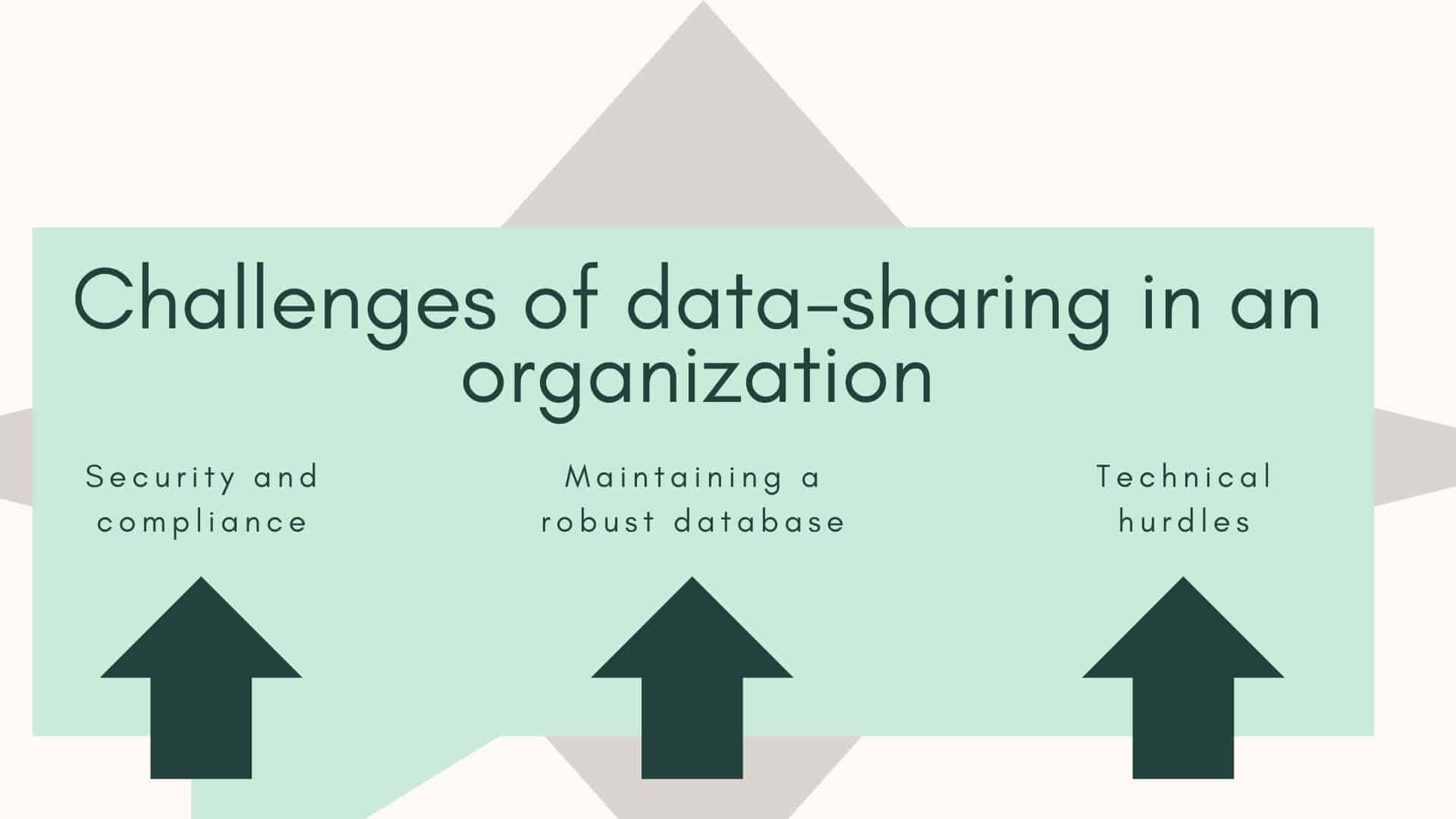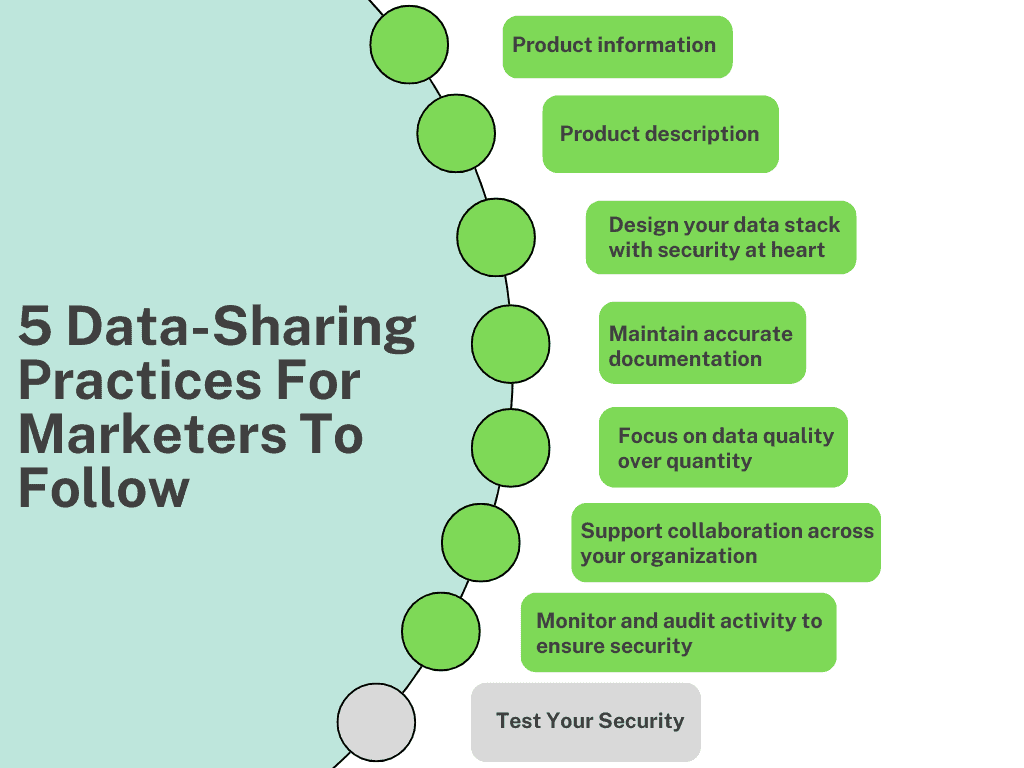We’re far past the point where a digital presence was a recommendation; it’s now the primary avenue for any marketer who hopes to succeed in this cut-throat landscape.
In tandem with the rise of digital competition, data has risen to become the number one commodity among businesses and social media marketers.
We can leverage data for so many critical functions, from internal performance analysis and marketing insights to product sales performance, but before it can empower our business aspirations, we need to capture and manage that data effectively.
Effective data-sharing practices enable many of the tasks we want to do as part of a holistic marketing strategy, but what can we do to ensure our precious data remains secure, accurate, and available to everyone within the company?
Let’s explore the world of data sharing.
What is data sharing?
Data sharing is the act of mobilizing data throughout a business, allowing various departments and individuals to access and use a dataset as required, all while maintaining a single source of truth for a company to work from.
This process democratizes data in many instances, removing limitations based on location or position, and is a vital part of promoting collaboration between various areas of an organization.
Businesses need the right safeguards, security, and technology to support long-term data-sharing practices.
When implemented correctly, a shared data stack can simplify numerous aspects of your marketing responsibilities and can help streamline customer relationship management too, as part of a multi-platform social media campaign.

Image sourced free from Pexels
Use cases to implement advanced data-sharing practices
Data management is a core part of every business, but data sharing has several specific use cases that will appeal to specific industries or structures.
We believe that any business can make use of effective data democratization, but we’ve included some notable use cases for data sharing within a business below.
Marketing and sales collaboration
The vast majority of information used in a marketing team will be incredibly helpful for sales to have access to.
The analysis and insights that marketing finds to inform their strategy can support sales teams when actively seeking fresh business or securing sales. This can include a variety of forms of hard and soft marketing data and can be sourced from external social media tools or marketing platforms.
Conversely, sales data is a key source of information for marketing teams to investigate and review when looking at where to take their marketing efforts.
Understanding hard sales data can inform previous marketing strategies and inform future strategies, and we need to ensure effective cross-pollination of data to achieve this. Utilizing data connectors can facilitate seamless integration and sharing of data across platforms, enabling a more comprehensive analysis and better-informed decision-making.
Interdepartmental insights to drive positive change
Data sharing isn’t just about letting the sales and marketing teams find new ways to promote products to customers, it can help improve internal operations and find more effective ways to work collaboratively with one another.
Review how data is used and shared across different channels to understand the flow of information within the business and explore ways to improve or streamline operations. If bottlenecks exist—fix them.

Image sourced free for use from Pexels
Empowering analytics and research
Effective analytics demands a robust data platform to work. Without long-standing data collection practices in place across the whole of a business, the likelihood that genuine insights will surface diminishes. To bolster data security and accuracy, businesses can leverage dedicated proxies within their data collection framework.
By constructing a data-sharing platform that draws from all key sources and complementing it with the right technology, such as the best machine learning models and capturing tools, businesses can open up a world of rich analytics previously locked away.
Collaboration with external businesses
Exciting opportunities to work with other businesses on projects or marketing pushes often require the sharing of important data to be successful, and this kind of vulnerability needs to be carefully managed.
A data-sharing platform that has stood the test of internal use and been properly vetted for security can be used to support external collaborations and create new marketing experiences for your customers to engage with.
Hacking social media trends
Brands trying to find Instagram hacks to crack a new target audience can leverage data from other social platforms and use like-for-like audiences as inspiration for their approach.
By cross-pollinating data from various social platforms, they can learn key insights about the demographic and position messaging more effectively.

Image created by author using Canva
Challenges of data sharing in an organization
Data-sharing practices do come with a range of challenges that can hamper businesses of all sizes, and it’s vital to be aware of the potential threats in your journey to an open data warehouse.
Security and compliance of shared data
Insecure data places your business’s value and assets out in the open for unscrupulous third parties to take advantage of.
At all stages of your data journey, security has to come at the forefront, and your data platform should be built with this ethos in mind. Compliance is another critical part of data management, as your business is legally bound by laws to ensure safe data handling practices.
There are countless scenarios where your business could be at risk of security or compliance issues.
For example, when a team member supporting a customer has to warm transfer the call to another department, the shared data required by both parties needs to be handled safely, and the customer’s identifiable information has to be protected.
They will need to explain what is a warm transfer, why the customer is being transferred, and then the new operative will likely need to verify their identity again to ensure security.
To complicate matters further, security is not a one-and-done scenario, it’s a long-term commitment that comes alongside the tangible benefits of an enterprise data management platform.
Maintaining a cohesive and robust data warehouse
As your data warehouse grows and more information is captured from various sources, it can very quickly become unwieldy to manage, and the operation will unravel as a result.
Whether you’re using a Hadoop distributed file system or a unified data lake, improper management will lead to major issues for everyone in the business further down the line.
All team members engaging with and manipulating data must be trained to ensure consistent data handling practices, and capturing methods need to be routinely reviewed and monitored to avoid incorrect collection, which can lead to poisoned datasets and loss of value.
Technical hurdles to capture, manage, and distribute data effectively
Even with security, compliance, and training covered, there is still the challenge of actually establishing the technology stack capable of collecting, managing, and distributing that data to the necessary locations—all while scaling with your company as it grows.
The best approach to protecting yourself from this pitfall is to have the right expertise in-house from day one.
Discuss the aspirations and growth trajectory, and explore what data could be collected and how it might be valuable to you in the short and long term. From this, map out an approach that will be sufficient for business needs.

Image created by author using Canva
5 data sharing practices for marketers to follow
Design your data stack with security in mind from the ground up
Given that you’ll be gathering data from both internal sources and from third-party resources, it’s important to ensure your whole data stack is built using a secure platform.
We must put in safeguards to protect from cyberattacks, intrusions, and misuse of any shared data, as this can lead to loss of revenue and even legal conflicts if customer data is leaked.
We recommend anonymizing any personal data you collect, as this will protect the individuals who provided it, and is one of many proactive measures you can take to keep your data secure.
Furthermore, ensure that you have the appropriate cloud-based security protections in place. It’s incredibly likely that the majority of your managed data will be stored in the cloud, decentralized from huge sections of your business, and your team will need access wherever they are. Implementing best practices for cloud security is crucial in these scenarios to safeguard your data.
These situations represent some of the greatest vulnerability windows where employees are considered, and necessary protocols should be implemented.
Maintain accurate records and documentation of data to promote accuracy
Much in the way that a marketing campaign will evolve over time, your data stack will mature and barely resemble the state it was in its infancy. Furthermore, as data is manipulated and used within your marketing team to research opportunities, the likelihood that it will further change grows.
Put documentation processes in place for any individuals or tools that engage with your stored data to avoid problems arising when data is improperly altered.
This has the added benefit of providing a digital paper trail of activity, which can be used to find new collaborative opportunities and as a method of promoting accountability for departments that benefit from any shared data.

Image sourced free for use from Pexels
Focus on data quality over data quantity
Too often, marketing campaigns are built on huge swathes of customer data that doesn’t have enough relevance. This leads to poorly-targeted messaging and an audience that isn’t receptive to the marketing materials created.
For example, Instagram and TikTok might be a goldmine for farming social media post ideas, while X or Facebook could be better positioned to explore customer sentiment toward your brand.
Focus on capturing and distributing only quality data that will be of genuine benefit to your specific goals, and ignore any sources of data that have proven to be unreliable or of poor quality.
Not only will this help your team to find trustworthy insights in a timely manner, but it will also reduce the technical burden required to collect and manage the growing datasets.
Support collaboration and accountability across the organization
It isn’t easy to consistently build innovative marketing campaigns, assess the constantly changing trends, and react accordingly to drive business growth. Sometimes, it takes an outside perspective and a fresh set of insights to help kickstart the creative engine.
Collaboration between marketing teams and other departments can be a fantastic way of involving the wider business with the direction of your brand’s message.
In many cases, customer-facing team members will have unique and valuable information that could shape your strategy. Explore any data they have to offer, and use it as part of your research.
Monitor and audit activity to ensure security
Always review activity across datasets regularly. This can help to maintain security, identify any maintenance issues that arise, and can help to spot opportunities for better handling of specific data.
Automated audits can be configured to reduce the burden of manually monitoring vast datasets, and any individuals who maintain the database will also be equipped to handle the majority of these auditing tasks.
By engaging in a regular auditing and monitoring schedule, you’ll be ensuring that anomalies are spotted and dealt with quickly, protecting the security and integrity of your valuable data. Additionally, implementing Incident Alerting, which may be achieved by using solutions like Opsgenie or alternatives, can further enhance your ability to respond promptly to any issues that arise.

Image sourced free for use from Pexels
The next steps
With the best practices outlined, it’s time to review your data management and start democratizing your marketing data today.
The more information at your marketing team’s disposal that they can engage with and analyze, the better ability they’ll have to craft powerful marketing campaigns for your flagship products.
Don’t be afraid to collaborate with other departments and individuals within the business to unlock fresh and creative ways to market your brand to customers, all backed by powerful analytics sourced from your captured—and, most importantly, shared—data.


